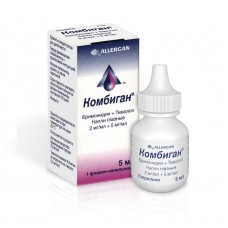Expiration date: 08/2026
Composition and form of release
Composition of the drug:
- Main active ingredients: brimonidine tartrate -2, 0mg, timolol maleate -5, 0mg.
- Additional ingredients: Benzalkonium chloride, sodium heptahydrate hydrophosphate, sodium dihydrophosphate monohydrate, hydrochloric acid or sodium hydroxide, water.
Combigan eye drops are available in the form of 2 mg / ml + 5 mg / ml solution in a 3 or 5 ml polyethylene dropper bottle, in a cardboard package-a bottle, instructions. They are available on prescription.
Pharmacological action
Combigan is a combined drug that contains two active substances: the adrenomimetic brimonidine, which stimulates alpha2-adrenergic receptors, and the beta-adrenergic blocker timolol. Both substances are able to reduce the increased intraocular pressure due to the mutual enhancement of the effect, which makes the hypotensive effect more pronounced (compared to the effectiveness of each individual component).
The first component, brimonidine, being an antagonist of alpha-adrenergic receptors, is characterized by thousands of times greater selectivity for alpha2-adrenergic receptors compared to alpha1-adrenergic receptors. Its selectivity is expressed in the absence of vasoconstriction (vasoconstriction) and mydriasis (pupil dilation). Brimonidine provides a hypotensive effect by increasing the outflow of intraocular fluid along the uveoscleral pathway.
The second component, timolol , is a non-selective beta-adrenoceptor blocker. It does not have internal membrane-stabilizing and sympathomimetic activity. The substance lowers intraocular pressure by reducing the formation of intraocular fluid. The mechanism of its action is not precisely established, perhaps it is associated with the suppression of cAMP synthesis or is caused by endogenous stimulation of beta-adrenergic receptors.
After instillation, the main volume of the drug is excreted by the kidneys in the form of metabolites for 5 days.
Indications for use
Combigan eye drops are used to treat the following pathologies:
- open-angle glaucoma,
- intraocular hypertension.
The drug is recommended if the effectiveness of local beta-blockers is insufficient.
Method of administration and dosage
Adult patients (including the elderly) are instilled one drop of Combigan in each eye twice a day, with a break of 12 hours, usually in the morning and evening.
If it is necessary to use more than one drop of the drug, the next instillation should be carried out with a 5-minute interval.
To reduce the risk of possible systemic absorption, it is necessary to press briefly (no more than a minute) with the tip of your finger in the area of the inner corner of the eye in the projection of the tear sac.
Contraindications
- Severe chronic obstructive pulmonary diseases (including AD or cases of bronchial obstruction, including in the anamnesis).
- Grade II and III AV block without artificial pacemaker, sinus bradycardia, heart failure (of any degree), cardiogenic shock.
- Therapy with antidepressants (tetracyclic and tricyclic) or MAO inhibitors.
- Individual intolerance to the drug.
- Pregnancy, breast-feeding period.
- Children's age.
Side effects
During the use of Combigan eye drops, the following side effects may occur:
- Conjunctival hyperemia, stinging and burning in the eyes, itching, allergic conjunctivitis, blepharitis, visual impairment, lacrimation, corneal erosion, dry eyes, spot keratitis, eye pain, irritation, foreign body sensation.
- Sometimes: visual impairment, follicular conjunctivitis, conjunctival edema, photophobia, papillary hypertrophy, conjunctival pallor, corneal infiltrates, corneal edema.
- Depression, nervous disorders.
- Sometimes: dizziness, fainting.
- Congestive heart failure, palpitations.
- Hypertension.
- Rhinitis, dry nose.
- Dry mouth. Sometimes: changes in taste sensations.
- Swelling and itching, erythema. Sometimes: allergic contact dermatitis.
In biochemical studies, people using Combigan may experience changes in liver function tests.
Overdose
Brimonidine.
When applied topically: loss of consciousness, significant decrease in blood pressure, bradycardia, fever, cyanosis and apnea.
When ingested: short-term confusion, central nervous system depression, loss of consciousness or coma, marked decrease in blood pressure, bradycardia, fever, cyanosis and apnea.
Treatment: Urgent hospitalization.
Timolol.
General overdose: bradycardia, marked decrease in blood pressure, bronchospasm, dizziness, headache, cardiac arrest.
Treatment: symptomatic therapy, hemodialysis is ineffective.
Interaction with other drugs
Special studies studying the therapeutic interaction of Combigan have not been conducted. However, with simultaneous use, it is worth considering the possibility of enhancing the effect of drugs that suppress the central nervous system (alcohol, barbiturates, sedatives, opium derivatives, general anesthetics).
Drugs that affect the metabolism or assimilation of circulating catecholamines (for example, chlorpromazine, methylphenidate, reserpine) are used with caution.
Concomitant administration of Combigan and MAO inhibitors is contraindicated.
Special instructions and precautions
Like any ophthalmic agents for topical use, Combigan is able to be absorbed systemically.
Benzalkonium chloride, which is part of the drug, sometimes causes eye irritation.
Before instillation of the Combigan, contact lenses must be removed. You can put them back on no earlier than 15 minutes after the procedure.
It is not allowed to touch any surfaces with the tip of the dispenser, in order to avoid infection of the contents of the bottle and the eyes.
Combigan is not used during lactation, since brimonidine and timolol are able to penetrate into breast milk.
The drug can affect the ability to drive vehicles and mechanisms, causing short-term visual impairment, sometimes weakness and drowsiness. If these symptoms occur, you should refrain from performing potentially dangerous activities.
Store the drug at a temperature of up to 25oC. After 28 days after opening the bottle, the drug is recommended to be disposed of, even if there is a certain amount of the drug substance left.


